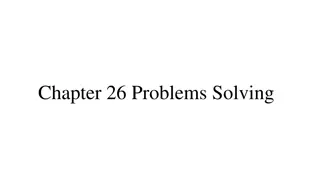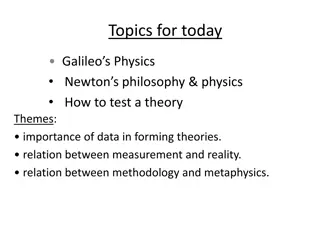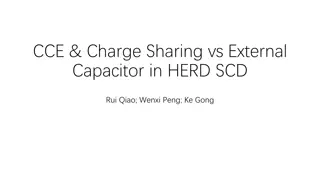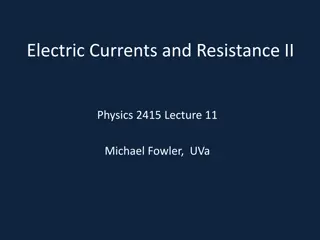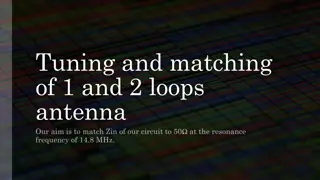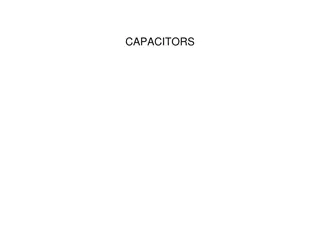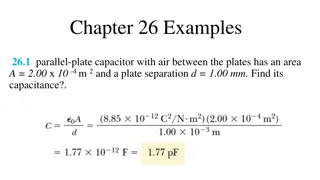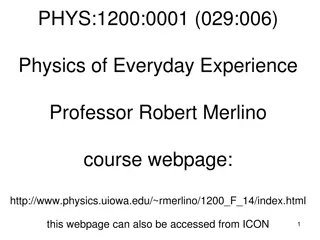Understanding Capacitors in Physics
Capacitors are electronic components that can store electric charge and energy. This content covers various concepts related to capacitors, such as capacitance, charge storage capacity, electric fields between plates, and capacitance calculations for different geometries. Problems and examples are provided to help reinforce understanding of these concepts.
Download Presentation

Please find below an Image/Link to download the presentation.
The content on the website is provided AS IS for your information and personal use only. It may not be sold, licensed, or shared on other websites without obtaining consent from the author. Download presentation by click this link. If you encounter any issues during the download, it is possible that the publisher has removed the file from their server.
E N D
Presentation Transcript
Chapter 25 Capacitors
Books Problems Ch 25 Problems: 4, 5, 8, 12, 17, 19, 27, 36, 41, 44, 48, 49, 50.
q V - + - + = - - - q C V + + + q = C V V+ 0 V C is capacitance = Ability to store the charges V V f = = V V i Unit of Capacitance q C = q Coulomb V = = = (F ) C Farad V Volt
q = (i ) C V V - + - - + + = E E - - -e -e -e -e -e + + 0 q = ( ) E ii d A 0 -e -e -e -e -e q + + + ddr 0 0 dr d q = = = = = = dr . dr . . dr V V V E E E ( ) E E d iii A 0 A = C = 0 C qd d A 0
- q - = (i ) C V + r + - + - + a + = E + - + + 0 - b q - E = - A 0 q = ( ) E ii 2 rL 0 q 2 2 q q q q dr dr q b + + + + a a a a a = = = = = = = = = = dr . dr . . dr dr E . V V V V E E E ln( ) ( ) dr dr dr ii 2 0 0 0 2 2 2 rL rL rL L L r r L a b b b b b 0 0 0 q 2 L = C = 0 C q b ln ln( ) b a 2 L a 0
- q - = (i ) C V + r + - + - + a + = E + - + + 0 - b q - E = - A 0 q = ( ) E ii b 2 4 r 0 dr r q q 1 a 1 b q q dr q q + + + + a a a a a = = = = = = = = = = . . . . V V V V E E E E dr dr dr dr dr dr dr ( ) iii 2 2 2 2 2 04 r r r 4 4 4 4 4 r b b b b 0 0 0 0 0 q 4 = C = 0 C 1 1 q 1 1 4 a b a b 0
- - + r + - 4 + = 0 C - + a 1 1 + + - + + a b - b - - 4 = 0 C 1 a 1 = 4 C a 0 For the Sphere of radius R = 4 C R 0
T072: Q# 14: The magnitude of the charge on each plate of a parallel plate capacitor is 2.5 C. If the capacitor has a plate area of 0.25 m2 and a plate separation of 0.1 mm, what is the electric field between its plates? (Ans: 1.1 106 V/m) T051:Q#14. A parallel-plate capacitor has an area of 16 cm2 . The plates are separated by 0.5 mm and are connected across a 60 V battery. Find the magnitude of the charge on each plate. (Ans: 1.7 nC) T-041-Q#1 A parallel-plate capacitor (with plates A and B) has circular shape of radius 6.0 cm separated by 2.0 mm. Find the total charges on both plates (A and B) when a 12 V battery is connected. (Ans: zero) T061:Q#15. A parallel plate capacitor has square shaped plates with an area = 4.1 10-3 m2 and 1.6 10-3 m separation. What charge will appear on the plates of such capacitor if a potential difference of 80 V is applied? (Ans: 1.8 10-9 C)
T103-Q18. Which of the following statements is TRUE? A) The capacitance depends on the geometry of the capacitor. B) The capacitance does not depend on the material separating the charged conductors. C) The energy stored in a capacitor does not change by changing its potential. D) Capacitors do not store energy. E) The capacitance of a capacitor doubles when the voltage across it is doubled. T102-Q14. A parallel-plate capacitor has a plate area of 0.20 m2 and a plate separation of 0.10 mm. To obtain an electric field of 2.0 x 106 N/C between the plates, the magnitude of the charge on each plate should be: A) 3.5 x 10-6 C T91-Q14. The capacitance of a parallel-plate capacitor is A) proportional to the plate area.
T061:Q#15. A parallel plate capacitor has square shaped plates with an area = 4.1 10-3 m2 and 1.6 10-3 m separation. What charge will appear on the plates of such capacitor if a potential difference of 80 V is applied? (Ans: 1.8 10-9 C)
T072: Q# 14: The magnitude of the charge on each plate of a parallel plate capacitor is 2.5 C. If the capacitor has a plate area of 0.25 m2 and a plate separation of 0.1 mm, what is the electric field between its plates? (Ans: 1.1 106 V/m)
-q -q +q +q +q -q = + + V V V V 1 2 3 V2 V1 V3 q q q q = + + C C C C 1 2 3 1 C 1 C 1 1 = + + V C C 1 2 3 +q -q Series: Charge is common
-q1 +q1 = + + qeq q q q 1 2 3 V -q2 +q2 = + + CV C V 1 C V 2 C V 3 V = + + C C C C -q3 1 2 3 +q3 V -qeq +qeq Parallel: Potential is common V
T111-Q18. Determine the equivalent capacitance of the circuit shown in Figure 7. A) 4.0 F T92-Q18. Three capacitors are arranged as shown in Figure 5. C1 has a capacitance of 5.00 pF, C2 has a capacitance of 10.0 pF, and C3 has a capacitance of 15.0 pF. Find the charge stored in capacitor C1 if the voltage drop across C2 is 311 V. A) 7.78 nC
T92-Q18. Three capacitors are arranged as shown in Figure 5. C1 has a capacitance of 5.00 pF, C2 has a capacitance of 10.0 pF, and C3 has a capacitance of 15.0 pF. Find the charge stored in capacitor C1 if the voltage drop across C2 is 311 V. A) 7.78 nC
T111-Q18. Determine the equivalent capacitance of the circuit shown in Figure 7. A) 4.0 F
T111-Q19. What is the charge on each plate on the 2- F capacitor in Figure 7? A) 10 C T111-Q16. If Vab is equal to 100 V, find the charge stored and the potential difference across the 35 F capacitor shown in Figure 4. A) 700 C and 20 V. T101-Q16. The equivalent capacitance between points a and b in the combination of capacitors connected as shown in Figure 5 is: A) 1.0 F
T91-Q16. Three identical capacitors, each with a capacitance of 6.0 F, are connected to a 50-V battery as shown in Figure 6. What is the charge stored by the system? A) 200 C T101-Q18. Capacitor C1 is connected to a battery and charged to 4.0 10 8 C. It is then disconnected from the battery and connected to two capacitors C2 and C3, as shown in Figure 6. The charge on the positive plate of C1 is 1.0 10 8 C. The charges on the positive plates of C2 and C3 are, respectively: A) q2 = 3.0 10 8C and q3 = 3.0 10 8C
T101-Q17. A 2- F and a 1- F capacitor are connected in series and a potential difference is applied across the combination. The 2- F capacitor has: A) half the potential difference of the 1- F capacitor T92-Q19. Each of the three 25- F capacitors shown in Figure 6 is initially uncharged. How much charge is stored in the combination after the switch S is closed? A) 0.30 C T92-Q20. In Figure 7, two capacitors, C1= 2.00 F and C2 = 5.00 F, are separately charged by a 100-volt battery and then connected, with opposite polarity, by closing switches S1 and S2. What will be the potential difference across C1 after the switches are closed? A) 42.9 V
T92-Q20. In Figure 7, two capacitors, C1= 2.00 F and C2 = 5.00 F, are separately charged by a 100-volt battery and then connected, with opposite polarity, by closing switches S1 and S2. What will be the potential difference across C1 after the switches are closed? A) 42.9 V
= - V ' dU dq V + - - + + ' q q = V - - -e -e -e -e -e + + C 'dq C q ' q dU = d ' q 0 -e -e -e -e -e = ' dU dq C V 2 q 2 = U C 1CV U = 2 2
2 U U U U U CV 2 u = u u = = = = = volume volume volume Ad Ad Ad A = 0 C d A 2 AV = 0 u 2 d . Ad 2 d V = 0 u 2 d 2 0E = u 2 V
T103-Q17. Two capacitors, C1 = 16 F and C2 = 4.0 F are connected in parallel and charged with a 50 V power supply. What potential difference would be required across the same capacitors connected in series so that the combination stores the same energy as when connected in parallel? A) 125 V T91-Q15. A capacitor is charged using a battery, and the energy stored in it is Ui. The battery is disconnected and then the charged capacitor is connected to an identical uncharged capacitor. The energy stored by the two capacitors is Uf. Which of the following is CORRECT? A) Uf = Ui/2 Book s problem- Two parallel plate capacitors 6 F each are connected in parallel to a 10 V battery. One of the capacitors is then squeezed so that its plate separation is halved. Because of the squeezing, (a) how much additional charge is transferred to the capacitors by the battery? (b) Find the increase in the total charge stored on the capacitors. (c) What is the change in energy stored in the capacitor? Ans: (a) 60 C (b) ?
T103-Q17. Two capacitors, C1 = 16 F and C2 = 4.0 F are connected in parallel and charged with a 50 V power supply. What potential difference would be required across the same capacitors connected in series so that the combination stores the same energy as when connected in parallel? A) 125 V
Books problem- Two parallel plate capacitors 6 F each are connected in parallel to a 10 V battery. One of the capacitors is then squeezed so that its plate separation is halved. Because of the squeezing, (a) how much additional charge is transferred to the capacitors by the battery? (b) Find the increase in the total charge stored on the capacitors. (c) What is the change in energy stored in the capacitor? Ans: (a) 60 C (b) ?
q C = V V V - - + + V - - - + + + - - - - V = ' + + + + -e -e -e -e -e - - - + + + k q V - - - - - - + + + -e -e -e -e -e + + + + q q q q - - - - + + + = = = = = C = C C ' ' ' C ' ' ' V V V V d The dielectric increases the capacity of charge storage and it is measured by dielectric constant k It will be able to store kq charge with voltage V. -e -e -e -e -e -e -e -e -e -e = ' C C When dielectric is introduced volume will decrease and capacitance will increase. V V = '
Material k vacuum 1 Dielectric constant k air 1.00054 Paper 3.5 oil 4.5 water 80.4 Titania Ceremic 130 Strontium Titanate 310 Capacitors using TiO2based Titanium Oxide based Second Generation Dielectric materials (TSDM) can reach up to billion. (~4 x 109) https://www.ncbi.nlm.nih.gov/pmc/articles/PMC5512908/
T111-Q20. A 10 pF parallel plate capacitor is charged with a 4.0 V battery. While the capacitor is still connected to the battery, a dielectric slab ( = 5.0) is inserted between the plates to completely fill the gap. How much electric potential energy is stored in the capacitor after inserting the dielectric? A) 4.0 10-10J T102-Q15. Figure 8 shows an arrangement of four capacitors, 500 F each with air between the plates. When the space between the plates of each capacitor is filled with a material of dielectric constant 2.50, the voltmeter reads 1000 V. The magnitude of the charge, in Coulombs, on each capacitor plate is: Fig#8 A) 1.25 T102-Q17. An air filled parallel-plate capacitor has a capacitance of 3.0 pF. The plate separation is then increased three times and a dielectric material is inserted, completely filling the space between the plates. As a result, the capacitance becomes 5.0 pF. The dielectric constant of the material is: A) 5.0
T111-Q20. A 10 pF parallel plate capacitor is charged with a 4.0 V battery. While the capacitor is still connected to the battery, a dielectric slab ( = 5.0) is inserted between the plates to completely fill the gap. How much electric potential energy is stored in the capacitor after inserting the dielectric? A) 4.0 10-10J
T111-Q20. A 10 pF parallel plate capacitor is charged with a 4.0 V battery. Then the capacitor is disconnected from the battery and a dielectric slab ( = 5.0) is inserted between the plates to completely fill the gap. How much electric potential energy is stored in the capacitor after inserting the dielectric? A)
T102-Q15. Figure 8 shows an arrangement of four capacitors, 500 F each with air between the plates. When the space between the plates of each capacitor is filled with a material of dielectric constant 2.50, the voltmeter reads 1000 V. The magnitude of the charge, in Coulombs, on each capacitor plate is: Fig#8 A) 1.25
Two different dielectrics: Series + + + + + + + + + - - - - - - - - - - - - - - - - - - + + + + + + + + + - - - - - - - - - + + + + + + + + + C 2 C 1 k1 k2 V ?2 ?1 + ?2 ?? = ?1 d2 d1 = ?1?1=?0? ?1 ?1 V = ?2?2=?0? ?2 ?2
Two different dielectrics: Parallel - - - - - - - - - - + + + + - - - - - - - - - + + + + + + + + + - - - - - - - - - - - - - - - - - - - - + + + + + + + + + + + + + + + + + + + + C 1 k1 + + + + + k2 C 2 V V = + = + ' ' ' C C C k C k C 1 2 1 1 2 2 ?1=?0?1 ?2=?0?2 ? ?
?0? ? 2 = ?1?1= k1 ?1 C 1 ?0? ? 2 C 2 = ?2?2= k2 ?2
?0?/2 ? = ?1?1= k1 C 2 ?1 ?/2 ? = ?2?2= k2 ?2
C2 C1 C3 Ans: 45.5 pF
Breakdown voltage (Vmax) There is a limit to store the charge. If you try to push too much charge, the corona discharge would take place of breakdown of dielectric would take place. - - - + + + Dielectric Strength (Emax): Maximum Electric Filed strength that dielectric can hold. - - - + + + - - - + + + - - - + + + ????= ?????
T173-Q18. A parallel plate capacitor filled with dielectric material between its plates has a capacitance of 50 pF. If the plate separation is 0.20 mm, find the maximum operating potential difference. (For the dielectric: dielectric constant = 6.0, dielectric strength = 150 106 V/m) A) 30 kV
T102-Q16. Two parallel-plate capacitors with the same capacitance but different plate separation are connected in series to a battery. Both capacitors are filled with air. The quantity that is NOT the same for both capacitors when they are fully charged is: A) The electric field between the plates B) The stored energy C) The potential difference D) The charge on the positive plate E) The dielectric constant T91-Q17. A 9.0 pF air-filled capacitor is required to store an energy of 7.4 J with a potential difference of 650 V. To do that, a dielectric should be inserted between the plates of the capacitor. What is the dielectric constant? A) 3.9 T101-Q20. A parallel-plate capacitor, of capacitance 1.0 10 9 F, with air between the plates, is charged by a battery to a potential difference of 12 V. The battery is then disconnected and a dielectric material with dielectric constant = 4.0 fills the space between the plates. The resulting potential difference, in volts, between the plates is: A) 3.0
Parallel Plate Capacitor Cylindrical Capacitor 2 A q L = = 0 = C 0 C V d ln b a 1CV U = 2 Spherical Capacitor 2 4 2 0E = 0 C = u 1 1 2 a b Capacitance of a single sphere = E 0 = 4 C R 0 Capacitors in Parallel = + + C C C C 1 2 3 = C C Capacitors in Series dielectric air 1 C 1 C 1 1 = + + V = air dielectric V C C 1 2 3
T081: Q15.: You are to connect capacitors C1= C and C2 = 2C to the same battery, first individually, then in series and then in parallel. In which of the following cases, the charge stored is the smallest? (Ans: C1 and C2 in series) T051:Q#17. Two capacitors, C1= 2 F and C2 = 6 F, are connected in parallel with a 60 V battery, as shown in Figure 2. The battery is removed and plates of opposite sign are connected. Find the final potential difference for each capacitor. (Ans: 30 V, 30 V) T042:Q#18: Three capacitors C1=5 micro-F, C2=10 micro-F and C3= 3 micro-F are connected to a 20 V battery as shown in Figure 8. Find the stored electric energy in C2. (Ans: 2.2*10**(-4) J.) T042:Q#16: Consider two separate capacitors: c1=30 F carries a charge of q1=6.0x102 C and c2=50 F, carries a charge of q2=1.0x103 C. If the opposite polarity terminals of the two capacitors are connected together as shown in figure 10, find the new voltage across c1. (Ans: 5.0 Volts.)
T042:Q#18: Three capacitors C1=5 F, C2=10 F and C3= 3 F are connected to a 20 V battery as shown in Figure 8. Find the stored electric energy in C2. (Ans: 2.2x10-4 J.) Book s problem- Two parallel plate capacitors 6 F each are connected in parallel to a 10 V battery. One of the capacitors is then squeezed so that its plate separation is halved. Because of the squeezing, (a) how much additional charge is transferred to the capacitors by the battery and (b) what is the increase in the total charge stored on the capacitors? Ans: (a) 60 C (b) ? T081: Q18.: Two capacitors each of capacitance 250 F are connected in parallel across a battery of 120V. How much energy is produced after both capacitors are completely discharged? (Ans: 3.6 J) T042:Q#18: Three capacitors C1=5 micro-F, C2=10 micro-F and C3= 3 micro-F are connected to a 20 V battery as shown in Figure 8. Find the stored electric energy in C2. (Ans: 2.2*10**(-4) J.)
S T092: Q19Each of the three 25- F capacitors shown in Figure 6 is initially uncharged. How (a) charge (b) energy is stored in the combination after the switch S is closed? 4000 V T071: Q2. When the potential difference across a 5 F capacitor is increased by 2 V, the energy stored increases by 10 %. What was the original potential difference? (Ans: 40 V). T052: Q#3: A parallel-plate capacitor has a plate area of 0.2 m2 and a plate separation of 0.1mm. The electric field between the plates is 2.0 106 V/m. The energy stored in the capacitor is: (Ans: 0.35 mJ) T072: Q17.: An air-filled parallel-plate capacitor is connected across a 24 V battery. When the battery is disconnected and then a dielectric slab is inserted into and fills the region between the plates, the voltage across the capacitor drops to 8 V. What is the dielectric constant of the slab? (Ans: 3.0)
T081:Q16.: Given a 9.4 pF air-filled capacitor, you are asked to convert it to a capacitor that can store 9.4 J, with a potential of 877 V. What is the dielectric constant of the material that you must insert between the plates of the capacitor? (Ans: 2.6) T071: Q4. A parallel-plate capacitor is completely filled with a dielectric of dielectric constant 6, has a capacitance of 50 pF. If the plate separation is 0.1 mm, find the plate area. (Ans: 0.94 cm2) Book s Problem- In figure the battery has a potential difference of V = 10.0 V and the five capacitors each have a capacitance of 10 F. What is the charge and energy on (a) capacitor 1 and (b) capacitor 2? c2 c1 V












